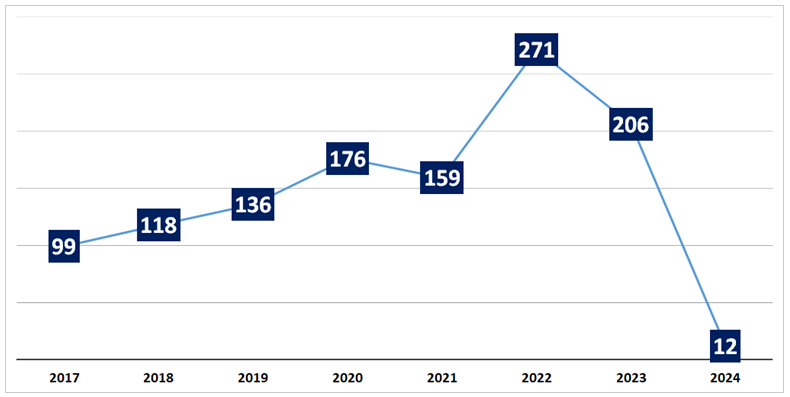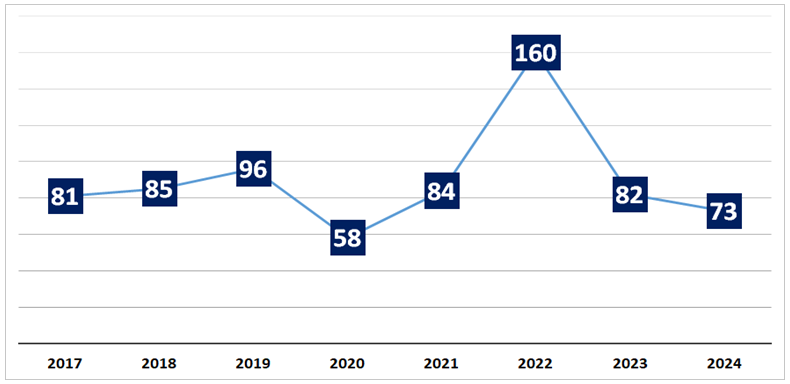Local export, which excludes re-export, witnessed a substantial decrease of 21% to USD 606 million in the first quarter of 2024 as compared to the same period the previous year. The aforementioned fall was primarily attributed to a decrease in the exports of copper ores and ferroalloys.
Whilst re-export is also a part of the GDP equation, local export plays a more significant role in the economy as the latter contributes more to job creation and tax revenue. Therefore, any fluctuation in local export figures have a more drastic impact on the economy. The share of local export in total export constituted 46% in the first quarter of the current year whilst the figure in the previous year reached 52% and exceeded 75% two years prior.
Notably, copper ores valued at USD 271 million were exported from January to March 2022 followed by USD 206 million in the first quarter of 2023. However, a mere USD 12 million worth of copper ores were exported in the first quarter of 2024. Furthermore, the average export price per tonne of copper ores has decreased from USD 2,722 in 2022 to USD 2,123.
Graph 1: Export of Copper Ores and Concentrates in the First Quarter (USD million)

Source: National Statistics Office of Georgia
It is worth mentioning that the decline in copper ore exports substantially impacted total exports, including re-exports, to China falling from USD 220 million to USD 64 million in the first quarter of 2024 as compared to the same period in 2022. Particularly, whilst copper ores valued at USD 178 million were exported in the first quarter of 2022, only USD 2.5 million worth of copper ores were exported in the first three months of 2024 to China.
Additionally, another instance of a significant contraction is reflected in the export of ferroalloys decreasing by 55% in the past two years. Furthermore, the tonnage of exports has declined by 11% due to both the halved price and decreased demand. The export price of a tonne of ferroalloy amounted to USD 2,000 in the first quarter of 2022, decreasing to USD 1,030 in the first quarter of 2024.
Graph 2: Export of Ferroalloys in the First Quarter (USD million)

Source: National Statistics Office of Georgia
The decreased exports of copper ore had a significant impact on exports to China whilst the halved exports of ferroalloy negatively influenced trade with the United States of America.
China was the top export partner whilst the USA ranked sixth in the first quarter of 2022. However, its positions fell to seventh and eighth places, respectively, in the first quarter of 2024.
Despite both ferroalloys and copper ores contributing to local export, the latter represent an instance of processing imported products. On an annual basis, Georgia purchased a total of USD 734 million of copper ores and sold USD 816 million after processing in 2022. However, imports decreased to USD 237 million and exports fell to USD 479 million in 2023.
On the contrary, ferroalloy is a fully locally produced commodity leading to a higher employment in ferroalloy production facilities. Hence, the decrease in ferroalloy exports induced more significant challenges in the economy.
Notably, wine emerged as the top locally exported commodity parallel to the decrease in exports of ferroalloys and copped ores. Wine exports to foreign countries witnessed a 48% increase reaching USD 84 million from January to March as compared to the same period last year.
The total monetary value of wine exports reached a record high with no other quarter experiencing wine sales of a similar magnitude. Conversely, a contrasting tendency can be observed in terms of pricing with the cost per litre of exported wine falling to its lowest mark since 2014 at USD 2.81 (the tonnage data for earlier time periods is not available on GeoStat). Apart from the decrease in prices, reliance on the Russian market has reached 78%. Notably, USD 65 million from the total USD 84 million of wine exports was sold on the Russian market where the export price per litre stands at an even lower USD 2.70. The aforementioned shift in the landscape of wine exports, characterised by both increased exports and decreased average prices, is attributed to a one-time factor, particularly an increase in wine import taxes in Russia. Exporters were aware of the impending tax increase from May 2024 already by the end of 2023, prompting them to accelerate wine exports and leading to a substantial surge in total wine exports in the first quarter. Furthermore, the Russian market’s tendency towards lower-priced wine exports naturally influenced the decline of the overall average price.







